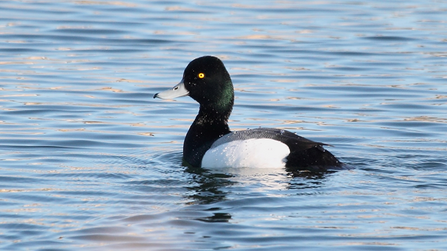
© Chris Farthing
Woodberry Wetlands - image by Hadi El Ali

© Chris Farthing
A typical May here involves a bit of bird movement at the start of the month, with the last few summer visitors arriving and some hope of the occasional passage migrant, before everything settles down around mid-month. From then on most bird activity is centred on breeding. However, 2020 is proving to be a far from typical year, and this year May produced the rarest bird of the year.
On the morning of the 15th, a bird resembling a scaup (main picture above) was seen distantly at the northern edge of the reservoir. Ducks resembling scaup, particularly in London and especially in May generally turn out to be male Pochard x Tufted Duck hybrids but on closer examination this bird was found to be the real deal. Scaup breed in northern Scandinavia and Iceland, and there are usually only a handful in the UK at this time of year, making this a remarkable sighting. The species has been recorded here once in the past, a juvenile in January 2010. It was fortunate that the bird favoured the northern part of the reservoir and as word slowly got around, a steady stream of birders visited to catch sight the bird from the New River path.
The scaup may have been the rarest bird here in May, but as in most years the most popular bird here has been mute swan (picture 1 below). The pair in the reservoir hatched seven cygnets with the pair on the New River adjacent to the reservoir hatching six, both around the 13th-14th. At the end of the month all thirteen cygnets were still doing well.
The rising and falling water levels in the reservoir meant that there was little breeding success amongst the other water birds, and the only other sighting of note amongst wildfowl was a female pochard x tufted duck hybrid (2) which was seen several times around the start of May.

© Chris Farthing
May is usually a quiet month for gulls, but we did have one visit from a sub-adult yellow-legged gull (3) on the 9th. The first common terns (4) of the year were seen on the 4th, and a pair were seen fairly regularly for the remainder of the month.
An impressive total of six raptors were seen in May, with sparrowhawk and peregrine being the most regular but with at least a couple of sightings each of hobby, kestrel, red kite and buzzard. One male sparrowhawk has developed an interesting hunting technique whereby it flies low across the reservoir, perhaps two feet above the water, before swooping upwards as it gets to the reed-bed to grab one of a large number of birds which are currently feeding on seeds at the top of the reed stems.

© Chris Farthing
The good numbers of raptors seen here through May is consistent with observations all over London. Another bird which has been seen more than usual in London this year is the cuckoo. This was also mirrored here when a female was seen in flight near the café on the 17th, before being seen an hour later on the west reservoir. Although a cuckoo was seen around the same time of year last year here, the previous sighting was in 1988.
Two more firsts for 2020 were a garden warbler which was seen and heard singing along the New River on the 17th, and a flyover rook on the 18th, a surprisingly difficult bird to see here. We also had a late passage common sandpiper on the 15th and increased sightings of little egret.
Whilst it has been a poor year so far for breeding water birds, the opposite has been true of the passerine species, which seem to have enjoyed the lack of disturbance. It is difficult to estimate the number of breeding pairs of reed warbler, but there are certainly well in excess of ten pairs and some were feeding young by the end of the month. Juvenile Cetti’s warblers, sedge warblers, blackcaps, chiffchaffs and reed buntings were all seen out of the nest during May.
The total number of bird species seen here in May was 67, a lower total than usual for May, most likely due to lack of coverage rather than less birds actually being here than usual. This does of course beg the intriguing question: what were the species we missed…?